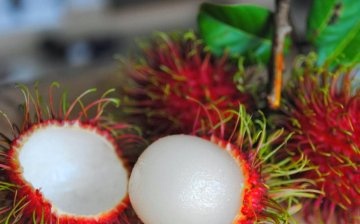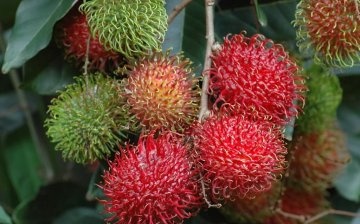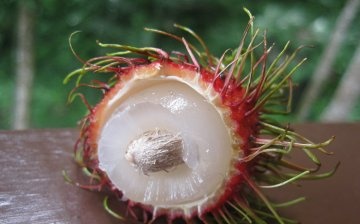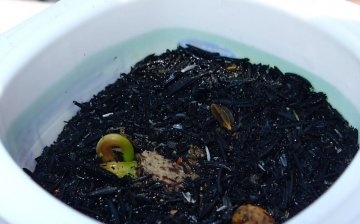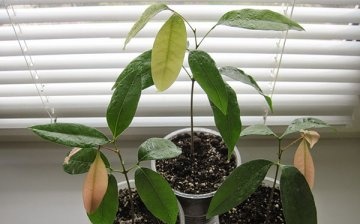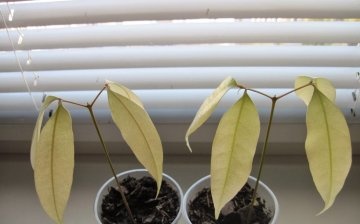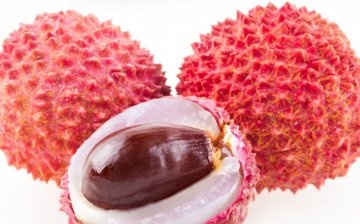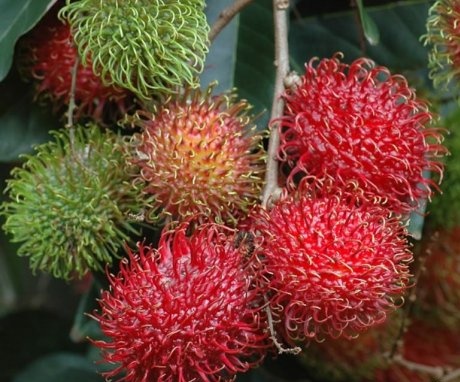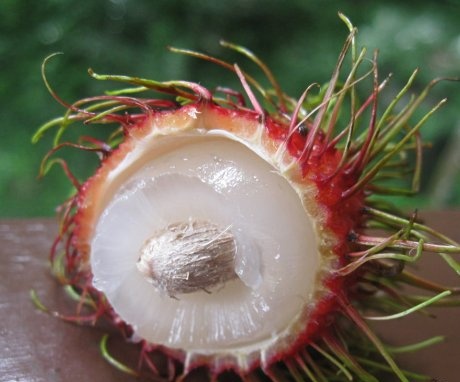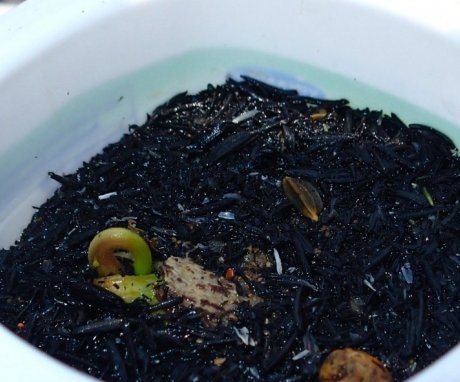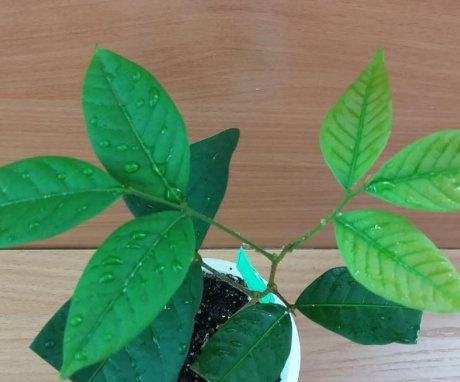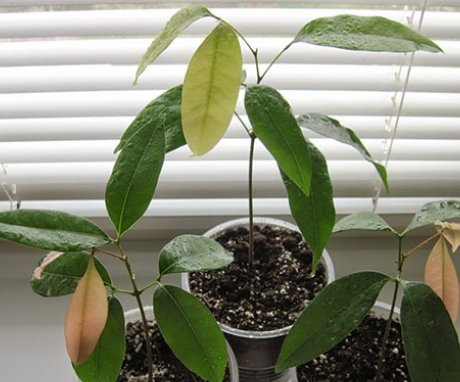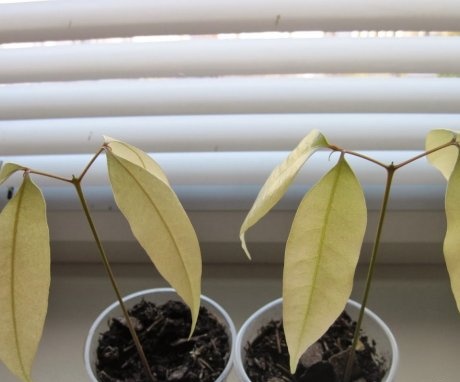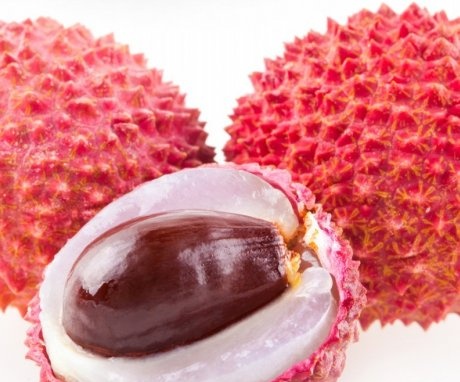Rambutan: proper plant cultivation at home
Many people love exotic things, so they tend to try various original products. One of these exotic fruits is rambutan. The fruit has become widespread in tropical countries, and in Russia it is considered exotic. Some gardeners dream of growing it on their own window or outdoors. For this event, it is worth familiarizing yourself with some of the structural features of the fruit, as well as the timing and rules for planting a plant using a seed.
Content:
- Features of the structure of rambutan
- Preparing the container, soil and seed
- Terms and rules for planting bones
- Plant care recommendations
- Everything you need to know about a transplant
- Possible growing problems
- Composition and useful properties of rambutan
Features of the structure of rambutan
Rambutan is an interesting exotic fruit found mostly in Southeast Asia, but also found in Thailand, Malaysia and Indonesia. The plant is a huge tree, stretching in height in natural conditions up to 25 m.When grown in gardening in a room, its height does not exceed 2 m.
Rambutan belongs to the Sapindov family tree. The fruit got its name because of the upper cover, pubescent with a large number of hard villi. Each eyelash averages 2-3 cm.
Plant characteristic:
- The plant is tall, its branches are spreading. At the same time, the tree never loses its deciduous plates, being rightfully considered evergreen.
- Leaves are oval in shape, located on the branches of 2-8 pieces, in pairs.
- The inflorescences of rambutan are inconspicuous, whitish, during flowering they are collected in small bunches, thanks to this, after the formation of fruits, the latter are contained on the branch up to 30 pieces.
- A distinctive feature of rambutan is its ability to bear fruit twice a year: in December and in July.
- When ripe, the fruit has a rounded shape, with a slightly elongated base. The fruit reaches 5 cm in length and up to 2.5 cm in diameter.
- Outwardly, the fruit is similar to hazelnuts, but its interesting color, which performs a protective function, has distinctive bright colors: red or yellow. They change as the fruit ripens. A green shell is observed under the upper peel, under which a jelly-like whitish core is visible.
- The pulp of the fruit is gelatinous, tender and juicy, the aftertaste gives off grapes, it has a whitish or yellowish-white tint, depending on the ripeness of the fruit.
There is a knuckle inside the fetus. It is used both for growing a new plant and for food. When consumed, the seed tastes like an acorn. But when fresh, the knuckle is forbidden to be used for food. It contains a harmful substance - tannin, which has the ability to cause intoxication of the body.
Preparing the container, soil and seed
If you have a strong desire to plant and grow a rambutan plant yourself, then this requires you to acquire a ripe fruit.Growing a plant from a cutting does not work. Therefore, even trying to grow a full-fledged bush from a cutting is not worth it.
Growing from seeds is not difficult; on the contrary, it has an interesting process.
For the sprout to begin to germinate, you need to pick up the perfect fruit. It should be ripe, without visible damage, depressed dents. It must be free from any disease or the appearance of a pest. If you find such marks, you should choose the best option.
You should know that if it is necessary to grow a plant from a drupe, then its preparation must be dealt with right before planting work. This is due to the fact that with a long preparation procedure, the seed loses germination.
Bone preparation rules:
- The bone is preliminarily cleaned of pulp, all the villi are carefully removed. This is required to prevent the process of decay of the remaining part of the fruit. After that, a clean, undamaged bone is washed under running water and gently dried with a soft cloth.
- Then, for better germination of the sprout and the formation of the root system, it is recommended to put the planting material in a liquid with a growth stimulator for a period of no more than 2 hours.
- At the last step, the newly washed bone is wrapped in cotton wool and laid out in a small container (a plastic cup from a children's dessert is perfect) and placed in a room with a temperature of at least +25 C in a well-lit place. It should be constantly monitored that the cotton wool is wet, so it is irrigated from a spray bottle.
Over the next 14 days, a young root should appear. If the process does not take place, this planting material can be thrown away and the germination procedure can be restarted with a new seed.
For planting, you need to select the ideal soil:
- A special soil mixture is selected - alluvial soil. It is sold in flower shops, but it is often difficult to get it. Therefore, in most cases, gardeners have to make their own soil. You will need to take universal soil and coarse river sand and mix thoroughly.
- In depleted soil, the plant will not be able to grow well and please with an abundance of deciduous plates. Therefore, it is worthwhile in advance to introduce nutrients into the soil in the form organics and mineral components... Nitrogen-containing substances, phosphorus and potassium are added as mineral additives.
- It is important that the soil meets the following requirements: it is well permeable to moisture and air, with an acidity of 4.5-6.5 pH.
The last step in preparing for planting a plant is a flowerpot. Initially, you do not need to immediately take a large container, it is enough to take a pot with a diameter of 10-12 cm. This volume will be enough for full-fledged growing of a young sprout. Subsequently, if necessary, it will be possible to transplant the grown plant. The main thing is that at the time of preparation it is required to check the presence of drainage holes through which excess moisture will come out. In their absence, the water will stagnate in the pot, provoking the development of pathogenic bacteria and the formation of rotten areas on the root system.
Terms and rules for planting bones
It is best to plant the selected fruit in the spring, but in some cases, planting is required in the fall. After the bone has hatched, it can be immediately planted in the ground. Drainage is laid out at the bottom of a pre-prepared flowerpot. For him, sea pebbles, expanded clay or crumbs of broken red brick are perfect. Then fertile soil is poured to the brim. In the middle, a recess is pulled out 2-3 cm from the surface of the earth.
The seed with a sprouted root is carefully separated from the cotton wool and laid out on the surface of the soil. After sprinkling with earth, the soil is shed well.After the procedure, a plastic bag is put on the pot or glass is laid on top. Such a process is necessary to create greenhouse conditions, which contributes to the fastest germination of a young cuttings. Periodically, it is required to ventilate the flowerpot, remove condensate and, if necessary, irrigate the soil surface.
It is important to monitor the humidity in the mini-greenhouse so as not to provoke the development of fungal diseases, especially the black leg, which tends to completely destroy the plant.
After the sprout appears, immediately remove both the glass and the plastic bag. In the future, the seedling will require minor care. In addition, some gardeners believe that it is necessary to stratify the bone. For this, the prepared planting material, instead of a warm room in a small container, is placed in cold conditions, where the air temperature does not warm up above +2 .. + 4 C. In such conditions, the plant is kept for 3-4 months.
The process has a beneficial effect on further germination, as well as on increasing the immune forces of the future tree. After stratification the bone is immediately placed in a flowerpot, and they wait until a young sprout appears. The duration of the appearance is 1-2 months. After germination of the sprout, its development slows down very much in the first 2 months, it grows only 3-4 cm in height.
Plant care recommendations
For a sprouted young sprout, as well as for an adult plant, the necessary care is required. If leaving is not done, the exotic pet will quickly wither and die.
It is recommended that the following conditions be met for a favorable cultivation of rambutan:
- Lighting - the tree is a resident of tropical forests and needs a lot of sunlight. But at the same time, the midday baking rays of the sun are destructive for rambutan. Therefore, a flowerpot with exotic in the summer should be placed on the east or west window, it is recommended to take the pot out to an open balcony, but so that the plant is shaded at noon.
- Temperature - rambutan is a tree that naturally develops in hot tropical forests, so the optimal temperature in the summer will be from +22 to +32 C. But in the latter case, it is required to create humid conditions for living. Otherwise, the soil will dry out quickly, which will lead to the death of the root system. In the winter months, it is required to ensure that the temperature in the room where the pet is located does not drop below +10 C.
- Watering - the introduction of nutrient moisture should be carried out infrequently and in moderate amounts. If you increase watering, then there is the possibility of stagnation of moisture in the rhizomes and the development of a fungal disease. The only thing is, while a young plant is growing, then watering should be daily, but in small amounts, so that the soil is always slightly moist, but not a swampy substance. In addition, excess moisture should be removed from the pallet and the leaf plates of the plant should be sprayed periodically. In summer or winter, when heating devices are working and the air humidity is significantly reduced, it is necessary to put a pallet with water next to the flowerpot, which will gradually evaporate and stimulate the necessary humidity for rambutan.
- Fertilizers and top dressing are necessary for the plant to actively develop and bloom in the adult period. The introduction of nutrients is carried out during the growing season, starting in spring. Every 10 days the plant should be fed as minerals, and organic, but fertilizers need to be changed periodically. No fertilization is required during the winter months.
- Trimming is practically not required for rambutan. It is carried out only when there is a desire to give the plant a specific shape. In other situations, the elimination of excess overgrowth is not required.
If you follow the simple rules for caring for an exotic pet, you can get a beautiful, tall tree in indoor conditions. At the same time, favorable growing conditions make it possible to achieve flowering and fruit formation.
Everything you need to know about a transplant
The transplant of a young plant is carried out only after the sprout has fully grown stronger. Such a process can be carried out in the 4-5 year of the rambutan's life. The procedure is required due to the fact that the root system becomes little space in the hatched container.
You do not need to dig up a young seedling. The transshipment method is ideal for transplanting. Previously, 1 or 2 days before the transfer work, the soil in the flowerpot is well spilled, but in moderate volumes, so that a swampy substrate does not form. On the scheduled day, the pot is carefully turned over and a whole lump of earth with intact rhizomes remains in the hands.
It is not worth shaking off the soil, if you nevertheless remove the earth, then the plant will take root for a long period, get sick and may even die. Therefore, you just need to carefully inspect the surface roots for the presence of rotten areas. If there are any, then they are carefully cut off with a garden tool. The latter must be well sharpened and pre-disinfected.
Fresh cuts are sprinkled with crushed activated carbon.
Then a lump of earth is installed in a prepared pot with drainage and filled with fresh fertile soil saturated with mineral substances. The plant is exposed in the central part, and the soil substrate is poured on the sides. Make sure that the neck of the tree is flush with the ground. In the future, the usual care of an adult exotic pet is carried out.
Possible growing problems
Rambutan, which is not difficult to grow at home, is in most cases a resistant plant, but if not cared for, it can be affected by diseases and pests. In some cases, pathogenic bacteria can develop on exotics. powdery mildew... This disease is the most common and most often manifests itself on the shoots. If an ailment struck the leaf plates, then a dark shade appears at their ends, over time the foliage gradually dries up completely and falls off.
To prevent disease and protect the plant from death, it is recommended to treat the leaf plates with chemical antifungal drugs. But with the fruits formed, you should choose either to stand the fruit until fully ripe, or to process and refuse to use the gifts of rambutan.
The invasion of parasitic individuals occurs at a time when normal conditions for growing rambutan are not maintained.
Parasites are caused by excessively dry and hot air. The most commonly affected leaf plate is the moth. If a pest is detected in a small amount, at the first stages of settlement, it is better to remove the insects on your own by hand using a cotton swab or soft napkin. They are collected and neutralized.
If the damage to the tree is already significant, then saline treatment is carried out. If this method does not produce the expected positive impact, then it is possible to save the life of an exotic tree only with the use of Actellik or Karbofors. If necessary, it is allowed to re-spray the deciduous plates after 7-10 days. But after the treatment procedure, it should be remembered that subsequently the fruits are strictly forbidden to be eaten, they are saturated with a large amount of toxins, and become very poisonous.
Composition and useful properties of rambutan
Rambutan in its homeland acts as a very nutritious and rich in vitamins and minerals product. It contains such minerals as phosphorus, magnesium, zinc, potassium, iron, sodium, calcium.The vitamins in its composition include thiamine, B vitamins (6 and 12), riboflavin, ascorbic acid, vitamin A, and folic acid.
Due to its high nutrient content, rambutan has a number of beneficial properties:
- Improves the appearance of the skin.
- It has a beneficial effect on the digestive processes in the human body.
- In its raw form, the fruit is used to eliminate diarrhea and as a treatment for dysentery.
- The digestible pulp helps to calm the inflamed lining of the stomach and intestines, which leads to the normalization of digestion processes.
- Regular consumption of fruits up to 7-8 pieces a day gradually normalizes blood pressure.
- The fruit is used as an anthelmintic.
- Leaf plates are used to block the development of headaches.
- A decoction based on rhizomes helps in reducing body temperature, stomatitis, the development of inflammation and with purulent abscesses on the skin.
In the homeland of rambutan growth, they are sure that 5 fruits eaten during the day reduce the possibility of the development of mutational cells in the human body.
Thus, rambutan is not only an interesting exotic fruit with an original appearance, but also a medicinal plant that has a beneficial effect on the patient. The main thing is, when growing at home, to adhere to proper care, which will allow you to grow a large tree that can bear fruit.
More information can be found in the video:



